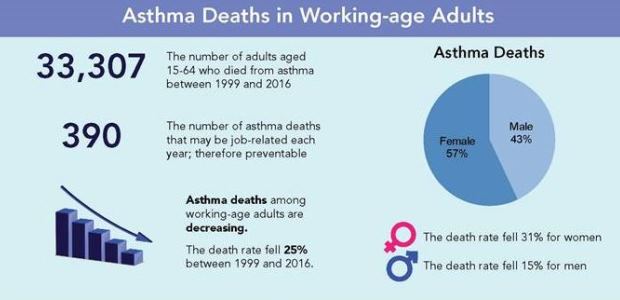
CDC Study Finds Highest Adult Asthma Deaths in Construction, Health Care
The annual number of asthma deaths among persons ages 15 to 64 declined significantly from 1999 to 2016, "most likely reflecting improvements in asthma management and effectiveness of prevention efforts," the authors find.
A CDC study on occupational asthma deaths in the United States finds an estimated 3,664 to 6,994, or approximately 204 to 389 annually from 1999 to 2016, that could be attributable to occupational exposures and were therefore potentially preventable. Published Jan. 19 in MMWR, the study indicates the highest asthma death rates were among adults ages 55–64 and that asthma mortality was significantly elevated among men in food, beverage, and tobacco products manufacturing, other retail trade, and miscellaneous manufacturing, and among women in social assistance.
The authors -- Opal Patel, Girija Syamlal, John Wood, Katelynn E. Dodd, and Jacek M. Mazurek -- are affiliated with the Association of Schools and Programs of Public Health/CDC Public Health Fellowship Program and/or the NIOSH Respiratory Health Division.
They report that in 2015, an estimated 18.4 million U.S. adults had current asthma and 3,396 adult asthma deaths were reported, and an estimated 11–21 percent of the asthma deaths might be attributable to occupational exposures. During the 18-year period from 1999-2016 for which they analyzed cause-of-death data and from that estimated occupational percentage, they conclude 1,573 to 3,002 asthma deaths in males and 2,091 to 3,992 deaths in females might have resulted from occupational exposures.
The highest significantly elevated asthma proportionate mortality ratios (PMRs) for men were for those in the food, beverage, and tobacco products manufacturing industry and for females were for those in the social assistance industry and those in community and social services occupations. By industry, the highest number of asthma deaths occurred among men in the construction industry and among women in the health care industry.
The annual number of asthma deaths among persons ages 15 to 64 has declined significantly during the period, "most likely reflecting improvements in asthma management and effectiveness of prevention efforts," they find, citing how replacing powdered latex gloves with powder-free natural rubber latex or nonlatex gloves reduced latex allergen exposure and substantially reduced work-related asthma among health care workers as an example.
Workplace exposures to cleaners, disinfectants, antibiotics, and natural rubber latex among health care workers, and to welding fumes and isocyanates (e.g., paints) among construction workers, are associated with work-related asthma, and the authors conclude that higher PMRs in certain groups might also be explained partly by workers leaving employment in industries and occupations with workplace exposures that exacerbate their asthma and moving to jobs with fewer workplace exposures.